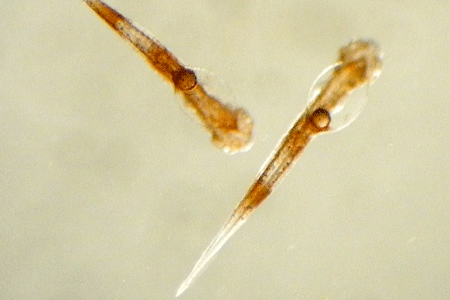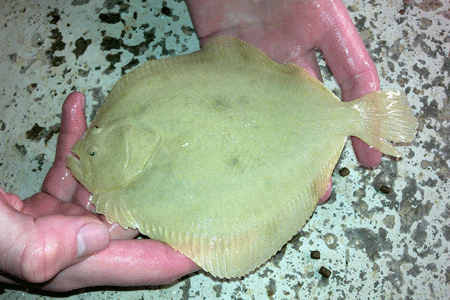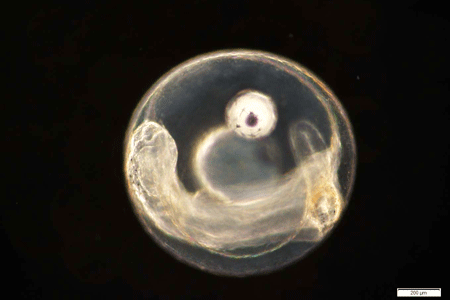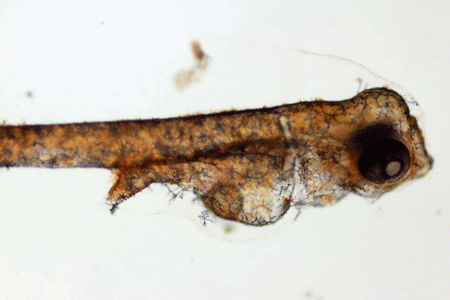It is possible to prevent illnesses in fish farming without using antimicrobial agents. A new research project and a partnership between industry and universities has demonstrated that the business potential in marine aquaculture can be increased in a sustainable manner.
By Iben Julie Schmidt
Fresh fish is exclusive food, and the kilo price for in-demand fish such as cod and turbot is so high that there is appreciable business potential in farming precisely these species. However there are also significant challenges preventing Danish producers from diving headlong into the cultivation of marine fish species. According to Kirsten Engell-Sørensen, owner of the analysis and consultancy company Fishlab, the primary concern is the risk of illness in the early stages of production.
“Suddenly losing a whole batch of fish on account of a bacterial infection is enough to sap the courage of most people,” she says.
Too small for vaccines
Fishlab assists Danish fish farmers through the steps of production that demand most knowledge and technology—the larval stage in particular, which is a bottleneck in the production of saltwater fish such as turbot. This is because the tiny fish larvae have to be fed on different types of live feed, which demands a relatively advanced ecosystem comprising algae, rotifers, crustaceans and fish larvae. At the same time, it is in this phase that the risk of illness is greatest.
Combating illness in aquaculture principally involves the administration of vaccines. However, fish cannot be vaccinated until they have reached a certain age, because the immune system in fish larvae is not sufficiently developed for a vaccine to have any effect. Therefore, if an infection arises while the fish are still larvae, it can wipe out an entire production.
Alternative to antimicrobial agents
“Even though bacterial infections can be treated with antibiotics, no-one wants to use large volumes of antimicrobial agents today on account of the risk of developing resistance with the serious negative consequences this may have on people’s health and the environment,” relates Kirsten Engell-Sørensen.
That is why Fishlab is one of six industrial partners in the ProAqua research project, which also involves participants from five research institutions (see fact box). The purpose of the project, which is headed by Professor Lone Gram from DTU Systems Biology, is to reduce the need for antimicrobial agents by developing new, sustainable strategies to prevent and combat illness in marine aquaculture.

Natural remedies
The aim is to develop what is known as a ‘probiotic combination strategy’ with the capacity to reduce mortality in marine aquaculture, particular during the larval stage. Taking as their starting point the microorganisms that are already to be found in the marine environments, the researchers in the project are working to isolate both suitable probiotic bacteria and bacteriophages (viruses).
Bacteria can develop resistance to both probiotic bacteria and bacteriophages, but as this involves different mechanisms, the project hypothesis is that a combination of these two strategies will reduce the risk of resistance developing, and thus assure the best possible prevention of illness.
“Specifically, we receive samples from the three aquaculture companies participating in the project and examine them to see whether they contain microorganisms, bacteria or viruses that prevent things that would otherwise make the fish larvae ill. The idea is that either by adding or stimulating the reproduction of precisely these microorganisms, it will prove possible to keep the pathogenic ones in check,” explains Lone Gram.
She then emphasizes that it is essential to seek out possible probiotic agents in precisely the places where they are to be used.
“We believe that we have the greatest chance of success if we base our work on the organisms that already occur naturally in the environment. Multiple trials with probiotics have shown that in practice it can be difficult to encourage bacteria to establish a permanent presence in a foreign environment. This means that to achieve a lasting effect you have to keep on adding them all the time, and that’s not a tenable approach in the long term.”
Hunting for probiotics
One of ProAqua’s industrial partners is the Greek company Selonda Aquaculture SA, a leading global producer of bass, sea bream and fry. When the labs analysed the samples from Selonda, they found what they were looking for immediately.
“The researchers say that we have the best probiotic Roseobacter bacteria in our tanks,” relates Nancy Durala, Head of the Department for Fish Pathology at Selonda, with some pride.
Roseobacter are a specific group of marine bacteria common to almost all parts of the world. From Selonda’s tanks and production equipment, researchers at DTU Systems Biology have now isolated several types of Roseobacter with the capacity to counteract the Vibrio bacteria that are a common cause of fish infections and elevated mortality among fish larvae. In contrast, the Roseobacter bacteria themselves are not harmful to fish larvae, the marine environment or people. This means that Roseobacter is an ideal candidate for a probiotic agent to prevent the outbreak of illnesses caused by Vibrio bacteria.
"The next step is to run large-scale trials to establish how best to administer the beneficial bacteria to make the process viable for fish farmers. Another aspect we are looking into is whether we can manipulate the system—for example, by changing the oxygen content or the volume of nutrient salts in a that simulates reproduction of the beneficial microorganisms. This would eliminate the need to add new doses all the time,” relates Lone Gram. She continues:
“Even if we succeed in optimizing their presence, it will still be necessary to add new doses from time to time, so the production of both bacteria and bacteriophages is required for future commercial application.”
Metagenomics
Tipping the microbiological balance in favour of the Roseobacter bacteria demands in-depth knowledge of the overall microbiological conditions in the entire ecosystem that the production facilities represent. Fortunately, recent advances in the field of DNA technology have made this work a little easier. For example, analysing the total volume of DNA in a water sample can reveal how many—and, more importantly, precisely which—types of microorganisms are present at a given time. This is known as ‘metagenomics’.
“We use metagenomics to determine what is in the system from the start. And when we have made changes such as returning the beneficial Roseobacter bacteria, we use metagenomics to establish how these changes have affected the system as a whole,” explains Lone Gram.
Partnership is the way forward
ProAqua’s success depends largely on close contact between researchers and industrial partners.
“A project like ProAqua gives us the chance to play an active part in the research. We normally spend all day working with production and therefore don’t have time to look for new solutions. However, participating in ProAqua means that we can talk to our partners at the universities about the challenges we are facing so they can work to come up with smart new solutions. At the same time, we now know each other really well, so we know who to call if problems arise in the future,” says Nancy Durala from Selonda.
Kirsten Engell-Sørensen from Fishlab also takes a positive view of the research partnership: “There’s no doubt that microbiological research and new knowledge of the kind we are generating in this project are the way forward towards a more profitable—and sustainable—fishing industry.”
Article from DYNAMO no. 38, DTU's quarterly magazine.
|

|
| Turbot is one of the popular species of fish that can generate good money for aquaculture operators.
However, the risk of illness is discouraging many fish farmers from making a commitment to it.
Work is now being done in a new research project to improve conditions for preventing illnesses in aquaculture using what is known as probiotic fish food—rather than combating diseases in fish with antimicrobial agents, for example.
|
 |
|
A turbot larva in its egg, just a few hours before hatching.
Researchers are closely studying the turbot and its patterns of illness, because there is great potential in aquaculture for this particular species of fish, if sustainable methods for preventing illness during farming can be developed
|
 |
|
The larval stage of the turbot’s life is the period when it is most vulnerable to illness, because it needs live food in the form of algae, crustaceans and other fish larvae.
The turbot larva shown here hatched three days ago.
|
Since the middle of the 1980s, an increasing amount of the fish we eat has come not from wild but from farmed populations, produced through what is known as ‘aquaculture’. Aquaculture is the fastest-growing branch of food production in the world.
While global demand for fish is rising, the risk of overfishing has resulted in the imposition of quotas on catches of edible fish, and this has led to stagnation or even reduction of the catches.
The increase in demand is therefore being covered by strong growth in aquaculture production. In 2001, total aquaculture production (fish, mussels and shellfish) amounted to 34.6 million tonnes; in 2011, it had risen to 62.7 million tonnes.
It is expected that this trend will continue. The cultivation of marine species accounted for just three per cent of total aquaculture in 2011, however.
Twenty years ago, farmed salmon (including Pacific salmon and trout) represented less than ten per cent of global salmon consumption. Today, it accounts for more than 60 per cent of the salmon market.
The growth in salmon consumption has only been possible due to the rising volume of farmed salmon, which currently totals around 1.5 million tonnes per year. Corresponding patterns can already be identified for other species of fish, such as the sea bream.